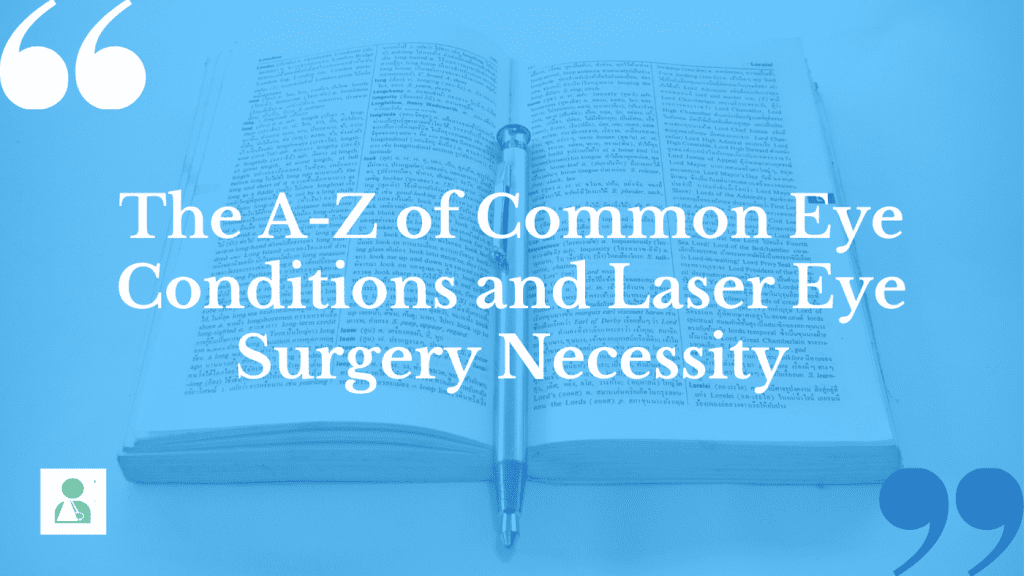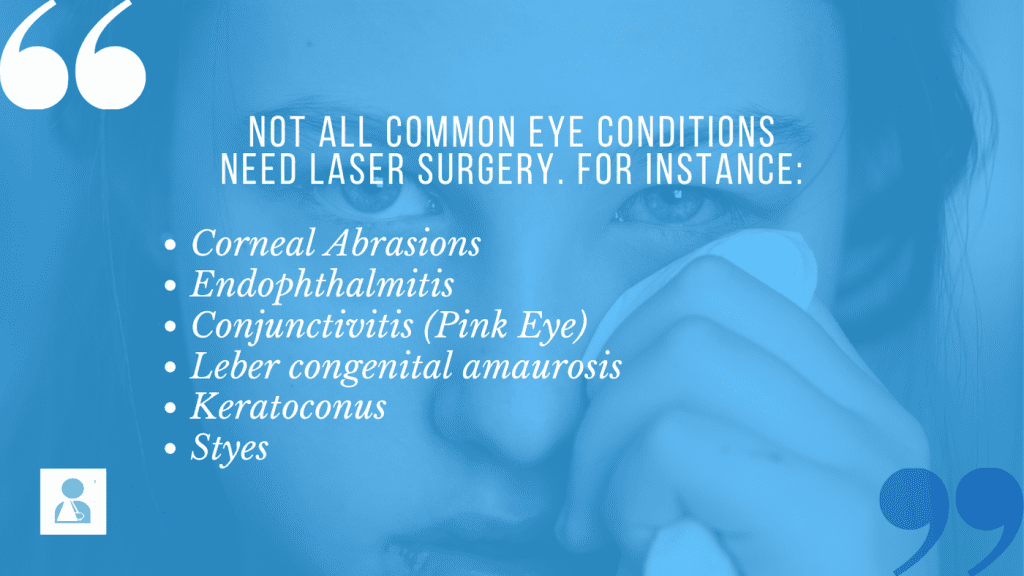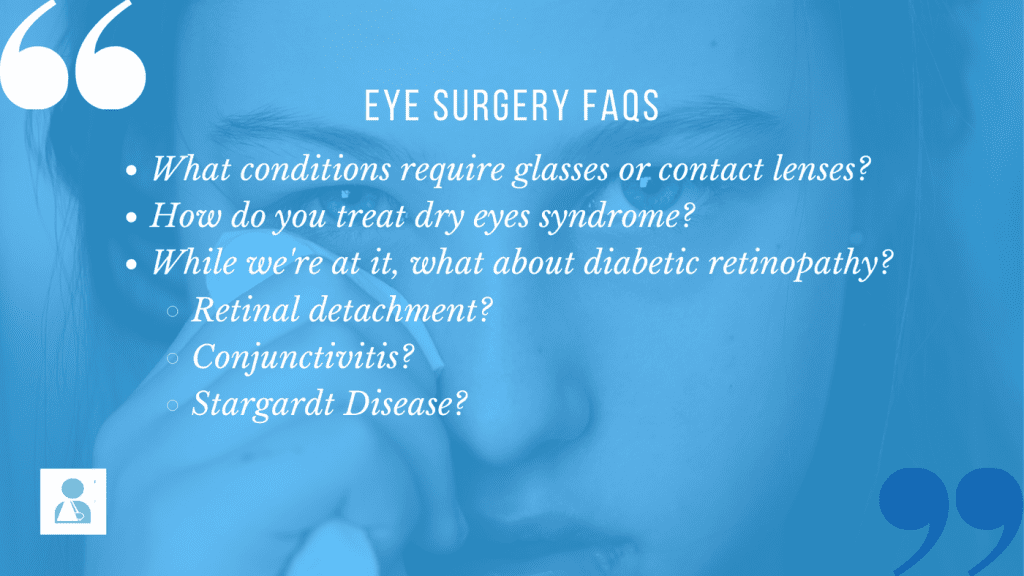Common eye conditions and whether you need laser surgery
June 8, 2020
What common eye conditions require laser surgery? In truth, we think it would be nice to list which vision problems/eye diseases do, and which ones do not.
- For instance, what conditions require the wearing of contact lenses?
- What’s the common treatment for dry eyes syndrome?
- What about diabetic retinopathy or retinal detachment?
To help with our glossary, we cite Moorfields NHS as one of the top eye care specialists in the UK. They list several common eye conditions and guidance on the appropriate treatments for them. Below, we identify whether some common eye conditions are suitable for laser eye surgery. However, with every condition, we recommend you speak with an eye doctor to decide what treatment suits your condition best.

A-Z of common eye conditions and if they require some type of laser eye surgery
Acanthamoeba keratitis
Known as AK, acanthamoeba keratitis is essentially a cornea infection.
Treatment Option: In short, AK requires eye drops (either antiseptic to steroid), but not laser surgery.
Achromatopsia
Achromatopsia, in essence, affects cone photoreceptors (i.e. colour and bright light vision).
Treatment Option: Achromatopsia often requires red colour lenses. However, surgery is not a common treatment.
Age Related Macular Degeneration (AMD)
In short, AMD takes place with damage to the macula, thus affecting central vision and perception of finer details.
Treatment Options: Injections are a common form of treatment. While surgery is possible, it’s not always necessary.
Amblyopia (Lazy Eye)
Lazy eye happens when one eye is used less than the other. In turn, the brain begins to rely on the better eye. Thus, the impaired eye struggles to gain even a basic field of vision, affecting your collective eye health.
Treatment Options: Laser surgery is a last-ditch option if you ignore the effects of amblyopia after age 7. However, it has a small success rate. Glasses are a must, and patches over the healthy eye train the lazy eye to get up to speed faster.
Astigmatism
With astigmatism, an eye’s front surface has an oval shape, not round and circular. Subsequently, it blurs the image, leaving you with blurred vision or blurry vision.
Treatment Options: Lasik eye surgery can help with this common eye condition. But common eye conditions methods for handling astigmatism are eyeglasses or a contact lens set.
Birdshot chorioretinopathy/uveitis
Birdshot uveitis stems from autoimmune problems, but the triggering of this condition is not for certain. When it happens, it can create floaters, cause light sensitivity to bright lights, trigger night blindness and colour blindness issues.
Treatment Options: The most common treatments – steroids & immunosuppressants – also come with significant side effects. Surgery is not effective for birdshot uveitis.
Blepharitis
In short, blepharitis is eyelid rim inflammation that consequently leads to red and swollen eyelids.
Treatment Options: It’s a long-term condition for which there is no cure. Essentially, daily cleaning treatments offer the best ways of coping. Antibiotics and artificial tear drop also help.
Cataract
We write a lot about the treatment of cataracts and surgical risks. In short, cataracts can be treated with surgery.
Chalazion
A chalazion is a type of eye cyst. By contrast to a stye, a chalazion is a small lump resulting from blockage of an eye gland. As an eyelid infection, a chalazion often ties in with blepharitis.
Treatment Options: Cotton buds are common home remedy treatment options you apply to the edge of your eyelids. Warm moist flannels are suitable for children.
Conjunctivitis (Pink Eye)
Conjunctivitis occurs from bacteria or virus affecting the conjunctiva lining your eyelids. Stickiness or watery eyes result, leading to regular soreness.
Treatment Options: Surgery is not necessary, but there is also no specific medication to treat conjunctivitis. Painkillers, artificial tear drops and regular eyelid cleaning are your best treatment options.
Corneal abrasion
A corneal abrasion occurs when there is a scratch on the clear section at the front of your eye. Trauma to the surface of the eye is a leading cause of these scratches.
Treatment Options: Again, surgery is not among common eye conditions treatments for a corneal abrasion. Treatments do include the likes of an eye patch, pain killers, and possibly some ointments.
Diabetic macular oedema
This is one of many common eye conditions for diabetics to pay close attention to. Blood vessels from the middle layer of the eye leak into the retina. Act quickly, because DMO left untreated can cause loss of vision.
Treatment Options: Surgery is, in fact, an option for DMO treatment. All About Vision states this treatment targets eye tissue with damage, or even the repair leaking blood vessels with “spot welding.”
Diabetic retinopathy
There are, according to Moorfields, two kinds of diabetic retinopathy. One is known as “proliferative diabetic retinopathy”, or PDR; the other is the previously mentioned diabetic macular oedema. Regardless of which type one has, causation is damaged retinal blood vessels.
Treatment Options: See the diabetic macular oedema treatment options statement. In short, laser surgery aims to lessen/remove fluid building up in the eyes.
Endophthalmitis
An infection that leads to the inflammation of tissues inside the eyes.
Treatment Options: No surgery is needed for this condition. Intravenous antibiotics, followed by drops and tablets when you get home, are the best option.

Epiretinal membrane
Also known as an ERM in the medical profession. The membrane is effectively scar tissue that forms, affecting the macula.
Treatment Options: Indeed, a type of surgery known as vitrectomy is the only treatment for this case. It requires stitches on your eye and an overnight eye patch.
Episcleritis
Basically, the episclera is a layer of tissue combining the conjunctiva and sclera (i.e. the white part of the eye). For reasons mostly unknown, episcleritis occurs when that layer suffers inflammation, leading to irritation, soreness and gritty discharge.
Treatment Options: In bad cases, it can become recurrent and require steroids and teardrops. However, for the most part, recovery can happen on its own.
Fuchs’ dystrophy
This is another type of cornea area eye problems. It happens as a result of an irregular functionality of cell/fluid pumping occurring in the eye. Consequently, the cornea is overloaded with water, and vision becomes watery.
Treatment Options: Surgical procedures known as corneal transplantations, one similar to the treatment for cataracts, help with this.
Glaucoma
We’ll expand on glaucoma in other writings in this space. In short, glaucoma consists of a collection of conditions regarding optic nerve damage.
Treatment Options: Yes, laser treatment is available, one that’s best utilised through screening and monitoring.
Hypermetropia
If you cannot see clearly up close without the use of glasses or contact lenses, you have hypermetropia or long-sightedness.
Treatment Options: As we say above, the condition requires glasses or contact lenses. However, laser eye surgery (particularly refractive surgery) may also be a viable treatment choice.
Keratoconus
File “keratoconus” under the cornea issues we cite in this space. With this illness, a conical bulge develops forms on the cornea, affecting focus.
Treatment Options: Eyeglasses or contact lenses will help, but surgery isn’t necessary.
Leber congenital amaurosis
LCA is one of the retinal common eye conditions. Starting often from infancy, LCA is an inherited gene defect that leads to tunnel vision.
Treatment Options: Sadly, LCA is untreatable, though gene therapy for LCA is being pursued.
Macular hole
A macular hole is fairly serious, as it is a hole that develops right in the centre of the retina.
Treatment Options: A macular hole is repaired through vitrectomy. The goal is to ensure vitreous gel stops pulling on the retina.
Myopia (short sight)
This is another of common eye conditions, one more commonly known as short-sightedness. In essence, myopia means a person has an ineffective long-distance vision.
Treatment Options: Much like long-sightedness/hypermetropia, short sight demands glasses or contact lenses. However, refractive surgery may also be a viable treatment choice.
Presbyopia
This is another of common eye conditions that need visual aids, like myopia. Effectively, presbyopia is the loss of reading vision.
Treatment Options: In the immediate term, presbyopia requires glasses or contact lenses. Yet refractive surgery is also a private firm treatment choice.
Ptosis
If you have an upper eyelid that droops, you have the common eye condition known as ptosis. A ptosis upper eyelid can obstruct your normal field of vision.
Treatment Options: Indeed, surgery is a tactic often deployed for cases of ptosis. This is particularly effective because it employs sutures to reattach muscles or tendons.
Retinal detachment
When the thin lining at the back of your eye pulls away from blood vessels, you have a retinal detachment.
Treatment Options: Surgery is a tactic for cases of retinal detachment, as it aims to seal the retinal holes.
Retinal vein occlusion
RVO is effectively the blockage of veins in your retina, causing leakage of blood or other fluids.
Treatment Options: Surgery isn’t common for RVO, as effective treatment surrounds minimising of the risks leading to it. However, retina laser treatment may be necessary when abnormal blood vessels grow on the iris.
Squint (strabismus)
Effectively, a squint is a common eye condition where eyes point in a variety of different directions. With this condition, your focus could possibly go inwards, outwards, up or downwards.
Treatment Options: Squint treatments depend heavily on what kind of squint you suffer from. That said, surgery is common, wherein surgeons tighten outside eye muscles. Also, glasses and eye exercises are common treatment methods.
Stargardt disease
This genetic eye condition involves a layer of cells in the macula. When you have Stargardt disease, however, those cells degenerate.
Treatment Options: Stargardt disease is untreatable at this time. Medical professionals are exploring therapies, including stem cell treatments. To live with the disease, UV-blocking
Styes
In short, a stye is a painful collection of pus building on an eyelid. In turn, it triggers an infection at the root of an eyelash.
Treatment Options: In fact, there is relatively little need to treat styes. Occasionally, a warm compress can help.
Uveal melanoma
Uveal melanoma is a rare malignant cancer. Consequently, there are several types of these increasingly common eye conditions.
Treatment Options: Surgery is a clear option, but it depends on what kind of melanoma. These options include ruthenium plaque, local resection (a tumour removal) or iridectomy (an iris melanoma removal).
Uveitis
For more on uveitis, please see our post above on Birdshot chorioretinopathy.

